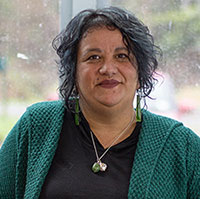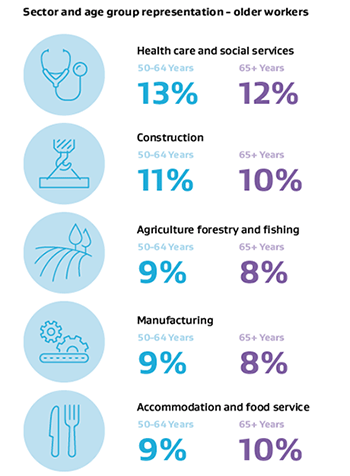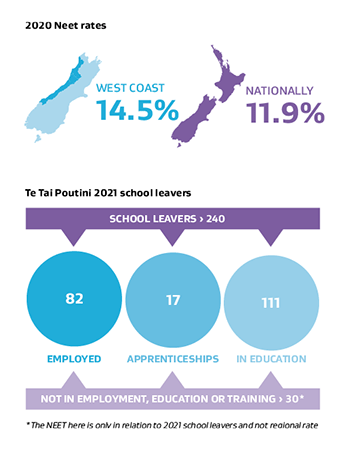Priority groups - Ngā Rōpū me Hāpai
As highlighted in the Government’s Employment Strategy, some of our people face poorer employment outcomes and opportunities.
On this page
In Te Tai Poutini we have identified five priority groups who will play an important part of our regional labour market supply. Many of the actions identified in this plan are designed to support these groups and help address the issues they face in successfully participating in our labour market.
Māori
Our region’s Māori population is increasing, and the median age of our Māori is getting younger. Currently over 4,200 people living in Te Tai Poutini identify themselves as of Māori descent.
Nearly 20% of our school aged children (years 1-13) identify as Māori, compared to 11.7% of the total NZ population.
In 2020, the unemployment rate of Māori was nearly twice that for the general population (7.4% verses 4.0%). Te Tai Poutini Māori are also less likely to work in highly skilled roles than the general population.
Creating career pathways and training in key sectors for Māori will not only benefit Māori but also our region’s future workforce. It will also ensure we include a younger skilled demographic in our aging workforce. Employers and industry will have a role to play in ensuring workplaces are inclusive, supportive, safe and healthy, productive and culturally sensitive.

I particularly loved the connection to the West Coast. The training gave me the practical skills I needed, and I was motivated to turn that into a business. I now supply dozens of galleries around the country and my goal is to grow that to the point where I can make a living for myself and my family entirely through my business
Flexible study options at Tai Poutini Polytechnic and a determination to succeed helped Ana Krakosky launch a successful jewellery business while still studying Jade and Hard Stone Carving.
Women - Wahine
Women account for about half of the filled jobs in Te Tai Poutini. However, women are:
- less likely than men to be in full-time employment (38.8% compared to 57.5%); and
- more likely to employed part time (22.3% compared to 9.2%); and
- less likely to be in the labour force (35.9% compared to 30.1%).
- more likely to be employed in service industries than men – ie accommodation and food services, health care and social assistance and retail trade.
Due to the prevalence of part-time work, women may be more likely to be underutilised than men. Reasons include lack of suitable childcare, other caring responsibilities, health issues or other impairments – meaning they can’t work or struggle to work more hours, or because of the way a job is structured (only offering full-time hours or night shifts). Underemployment has been linked to negative life outcomes.

Older workers - Ngā kaimahi kua tūnohunohu
Our older workers (people aged 50+ years) contribute to about 6,300 filled jobs in the region (35% of total filled jobs).
By the year 2038, 31% of our population is forecast to be aged 65 years and over, up from 22% in 2021.
While many of our older population are still engaged in the workforce, not all have positive outcomes. For example, when older people lose their jobs, it tends to take them longer than other groups to find new employment and they usually experience a wage drop. Our jobseeker numbers reflect this trend with about 940 people aged 55 to 64 years on a main benefit. This age group represents the largest share of jobseekers and has increased by about 150 across the region since the emergence of the Covid-19 pandemic.
Data table for graph
Youth - Rangatahi
 As of 1 July 2021, there were about 3,300 school aged children (years 1 to 13).
As of 1 July 2021, there were about 3,300 school aged children (years 1 to 13).
About 300 (11%) of our students leave secondary school each year. Approximately 17% (57) of our students leave with no qualifications.
We have a high rate of youth not in employment, education, or training (NEET). In 2020 the NEET rate was 14.5% compared to the national average of 11.9%. According to the West Coast Regional Council, as of December 2021, there were 270 people aged 18-24 years on a main benefit. Nationally, this age group has one of the highest levels of unemployment and non-participation with education.
From a study completed in 2022, of the 1,140 students involved in the West Coast Pathways Programme - 901 had low confidence when considering choosing courses and a career that fitted with their interest. Another 629 were unsure of their proposed destination once they left school.

At home I volunteered at the public library and at our school’s KickStart Breakfast Club and Barista Programme. This mahi and the ample opportunities available on the Coast have motivated me to return and work in the law profession on completion of my degree.
Scarlett Hamilton was one of the worthy recipients of the Development West Coast Tertiary Scholarships in 2021. Designed to grow and retain talented youth, the scholarship offers summer work and guaranteed employment on the West Coast on completion of tertiary study. A former Buller High School student, Scarlett is studying towards a double degree in law and arts at the University of Canterbury.
Disabled people and/or people with health conditions - Te Hunga Whaikaha, te Hunga hoki/rānei kua Pāngia e T/ētahi Mate Hauora
Nationally, about 1 in 4 people are limited by a physical, sensory, learning, mental health or other impairment. Census data tells us that 9% of people locally have an activity limitation.
Nationally, those people with disabilities or health conditions have a much lower labour force participation (47% vs 82.1% for non-disabled) and are twice as likely to be underutilised and earn about $150 less per week.
Since the start of the Covid-19 pandemic the region has seen an increase in the number of people receiving job seeker health and disability, up from about 430 to 650, including 255 in Buller, 285 Grey and 110 in Westland. More than half are receiving support due to psychological or psychiatric conditions.
In addition, there are 910 people who receive Supported Living Payments. These are payments for people who have or are caring for someone with a significant health condition, injury or disability meaning that suitable work is unlikely within the next 2 years.

As a part of the West Coast’s new Education to Employment Pathways programme I now feel like someone is listening to me and trying to help me. For once, I feel that I am being heard and not judged, not pushed aside anymore. Instead, I am finally getting the help that I need and deserve. Just because I’m different and have disabilities, doesn’t make me any less important. I just need to be given the chance so that people can see me for the things that I can do.
West Coast Rangatahi

